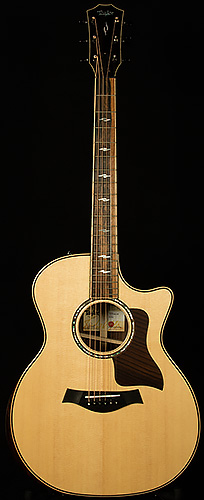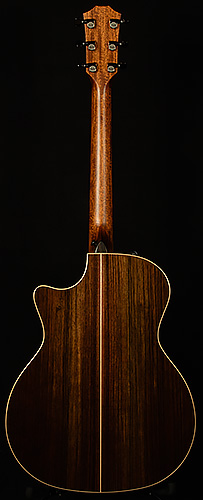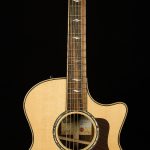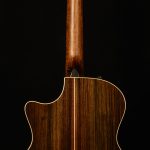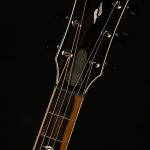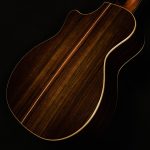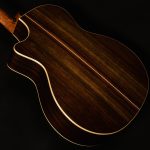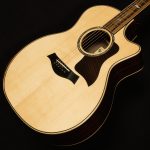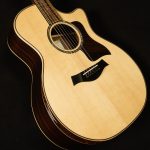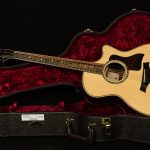A Fresh Take on an Old Favorite
Several years ago, it was difficult to imagine anyone improving upon Taylor's vaunted 800 series. Most people would be terrified to try and fix something so decidedly unbroken, but Andy Powers is not most people. He built his first guitar at age eight, and he's had his nose to the grindstone ever since. So, the redesigned 800 series is a celebration of a storied tradition by a builder with twenty years of experience, but it also injects that tradition with oodles and oodles of youthful energy. This combination of innovation and experience has resulted in a truly stunning final product.
To start, they recalculated the ideal thickness of every top, back, and side of every guitar, and they decided to finish each piece of wood with a very thin polyester gloss
Read More...A Fresh Take on an Old Favorite
Several years ago, it was difficult to imagine anyone improving upon Taylor's vaunted 800 series. Most people would be terrified to try and fix something so decidedly unbroken, but Andy Powers is not most people. He built his first guitar at age eight, and he's had his nose to the grindstone ever since. So, the redesigned 800 series is a celebration of a storied tradition by a builder with twenty years of experience, but it also injects that tradition with oodles and oodles of youthful energy. This combination of innovation and experience has resulted in a truly stunning final product.
To start, they recalculated the ideal thickness of every top, back, and side of every guitar, and they decided to finish each piece of wood with a very thin polyester gloss finish to optimize projection. Also, each body size features side bracing to help improve the strength of the connection between the top and back to increase frequency response. This doesn't even take into account the redesigned ES-2 System--which delivers truly incredible plugged-in tone--or the stunning new aesthetic updates like figured maple binding, an Indian rosewood pickguard, and an abalone rosette.
A V-Classic
I would be remiss if I failed to mention another of Andy Powers's innovations: Taylor's new V-Class bracing. It's an elegant solution to a problem that has plagued luthiers for decades. For years, acoustic guitar builders had to compromise between volume and sustain. Flexibility equals volume, and stiffness equals sustain. Obviously, a piece of wood cannot be rigid and flexible at the same time, so builders had to go for one or the other.
Andy Powers wanted to have his cake and eat it, too. After much tinkering, V-Class bracing was his elegant solution to the problem that has plagued luthiers for centuries. As the name implies, V-Class bracing features two long pieces of wood that make a "V" shape together. The bracing is quite thin and flexible near the rear bout, but it becomes thicker as you get closer to the soundhole.
So, you get volume from the flexible parts of the bracing, and sustain from the rigid parts! Many areas of the guitar neck that typically sound weak (ninth fret on the G string, for instance) have just as much presence, resonance, and sustain as the low E. As a result, the 814ce sounds supremely balanced and sculpted. When you hear one played live in the room, you'd swear a mix engineer had already done a bunch of post-production work on it. And, it gives the guitar piano-like note separation and crystalline clarity even when you play fancy jazz chords!
Intonation Station
V-Class bracing also does wonders for the guitar's intonation. Are you ready to have your mind blown? When I visited the Taylor headquarters El Cajon, Andy Powers explained that an acoustic guitar's intonation is not necessarily just the sum of the typical adjustments like saddle height, nut slots, and neck angle (though they do play a part). The way that the
actual guitar itself vibrates also has a lot to do with how in-tune it sounds.
Andy told me to picture it like this: when you take close-up slow-motion footage of a guitar's top with a high-speed camera as someone plays it, you can see the top move vividly. On a traditional X-braced guitar, the top vibrates in a disorderly, disjointed manner. This can cause a guitar with the perfect saddle height and neck angle to sound out of tune when you play a big open chord.
By contrast, guitars with V-Class bracing vibrate in a much more orderly manner. The graduated braces compel the energy from the player's attack to move from the thin outer part of the bracing to the thicker inner part in an efficient manner. If you were to take a high-speed shot of a V-Class top, you would see it rock back and forth evenly in a pleasing pattern. Because of that V-Class magic, the 814ce sounds so in-tune that it's scary.
[collapse]


